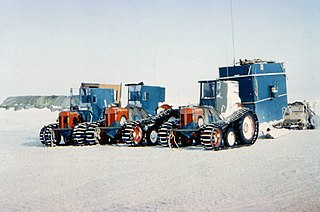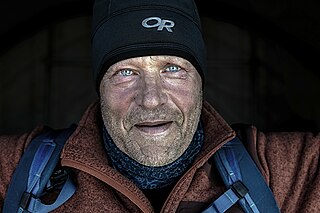Related Research Articles
Transport in Antarctica has transformed from explorers crossing the isolated remote area of Antarctica by foot to a more open era due to human technologies enabling more convenient and faster transport, predominantly by air and water, but also by land as well. Transportation technologies on a remote area like Antarctica need to be able to deal with extremely low temperatures and continuous winds to ensure the travelers' safety. Due to the fragility of the Antarctic environment, only a limited amount of transport movements can take place and sustainable transportation technologies have to be used to reduce the ecological footprint. The infrastructure of land, water and air transport needs to be safe and sustainable. Currently thousands of tourists and hundreds of scientists a year depend on the Antarctic transportation system.

The history of Antarctica emerges from early Western theories of a vast continent, known as Terra Australis, believed to exist in the far south of the globe. The term Antarctic, referring to the opposite of the Arctic Circle, was coined by Marinus of Tyre in the 2nd century AD.

Ann Bancroft is an American author, teacher, adventurer, and public speaker. She was the first woman to finish a number of expeditions to the Arctic and Antarctic. She was inducted into the National Women's Hall of Fame in 1995.

The Commonwealth Trans-Antarctic Expedition (CTAE) of 1955–1958 was a Commonwealth-sponsored expedition that successfully completed the first overland crossing of Antarctica, via the South Pole. It was the first expedition to reach the South Pole overland for 46 years, preceded only by Amundsen's expedition and Scott's expedition in 1911 and 1912.

The United States Antarctic Program is an organization of the United States government which has presence in the Antarctica continent. Founded in 1959, the USAP manages all U.S. scientific research and related logistics in Antarctica as well as aboard ships in the Southern Ocean.

Multiple governments have set up permanent research stations in Antarctica and these bases are widely distributed. Unlike the drifting ice stations set up in the Arctic, the Research stations of the Antarctic are constructed either on rock or on ice that is fixed in place.

Børge Ousland is a Norwegian polar explorer, photographer and writer. He was the first person to cross Antarctica solo.

Scouting in the Antarctic is maintained by a single troop of Argentinian Scouts and also by visiting Scouts from other nations who are participating in expeditions and research projects.

Robert Charles Swan, OBE, FRGS is the first person to walk to both poles.

Patriot Hills Base Camp was a private seasonally occupied camp in Antarctica. It was located in the Heritage Range of the Ellsworth Mountains, next to the Patriot Hills that gave it its name.

Farthest South refers to the most southerly latitude reached by explorers before the first successful expedition to the South Pole in 1911. Significant steps on the road to the pole were the discovery of lands south of Cape Horn in 1619, Captain James Cook's crossing of the Antarctic Circle in 1773, and the earliest confirmed sightings of the Antarctic mainland in 1820. From the late 19th century onward, the quest for Farthest South latitudes became in effect a race to reach the pole, which culminated in Roald Amundsen's success in December 1911.

Rolf Bae was a Norwegian Arctic adventurer and mountaineer. Bae operated an adventure company called Fram, specializing in Arctic and Antarctic travel and survival courses.

The South Pole, also known as the Geographic South Pole, Terrestrial South Pole or 90th Parallel South, is one of the two points where Earth's axis of rotation intersects its surface. It is the southernmost point on Earth and lies antipodally on the opposite side of Earth from the North Pole, at a distance of 12,430 miles in all directions.

This article is a list of English-language nonfiction books which have been described by reliable sources as in some way directly relating to the subject of Antarctica, its history, geography, people, etc.
Hercules Inlet is a large, narrow, ice-filled inlet which forms a part of the southwestern margin of the Ronne Ice Shelf. It is bounded on the west by the south-eastern flank of the Heritage Range, and on the north by Skytrain Ice Rise. Hercules Inlet marks the southern end of Zumberge Coast and the northwestern end of Queen Elizabeth Land. The inlet was named by the Advisory Committee on Antarctic Names for the LC-130 Hercules aircraft used by the U.S. Naval Support Force, Antarctica, as a photographic and load carrying plane.

Felicity Ann Dawn Aston is a British explorer, author and former climate scientist.

There have been women in Antarctica and exploring the regions around Antarctica for many centuries. Oral tradition of Māori explorers reaching Antarctic waters as early as 650 CE, put women on the Antarctic map. The most celebrated "first" for women was in 1935 when Caroline Mikkelsen became the first woman to set foot on one of Antarctica's islands. Early male explorers, such as Richard Byrd, named areas of Antarctica after wives and female heads of state. As Antarctica moved from a place of exploration and conquest to a scientific frontier, women worked to be included in the sciences. The first countries to have female scientists working in Antarctica were the Soviet Union, South Africa and Argentina.

This is a Timeline ofwomen in Antarctica. This article describes many of the firsts and accomplishments that women from various countries have accomplished in different fields of endeavor on the continent of Antarctica.

Ramón Hernando de Larramendi is a Spanish polar explorer and adventurous traveler who has promoted and developed a WindSled unique in the world, intended for the research in Antarctica and Greenland. He has travelled more than 40,000 km in polar territories.
References
- ↑ South to the Pole by Ski/Nine Men and Two Women Pioneer a New Route to the South Pole Hardcover – September, 1990 by Joseph E. Murphy (Author)
- ↑ "Whitehorse Daily Star: City Resident Makes Polar History". Whitehorse Daily Star.
- ↑ "AdventureStats - by Explorersweb". www.adventurestats.com.
- 1 2 3 "Expedition". www.oas.org.
- 1 2 3 "POLE TO POLE 2000 INTERNATIONAL TEAM". www.newzeal.com.
- ↑ Buchanan, Rob (November 1, 2001). "Beat the Crowds. Antarctica Now". Outside Online.
- ↑ "Our History". Antarctic Logistics & Expeditions.
- ↑ "Martyn Williams - Platinum Speakers and Entertainers Bureau". www.platinumspeakers.com.au. Archived from the original on 2015-03-30.
- ↑ "Haritaki Plus". Haritaki Plus. May 13, 2019.
- ↑ "Fearless - documentary". November 28, 2011 – via YouTube.